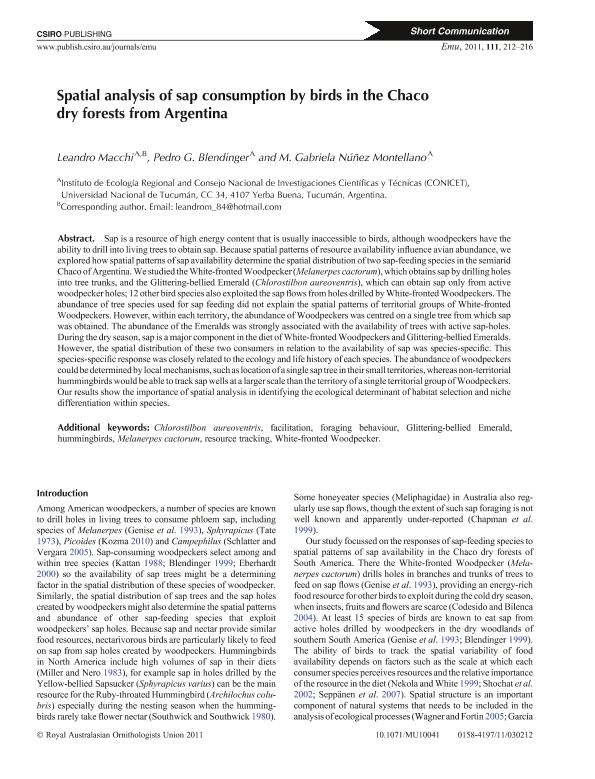Mostrar el registro sencillo del ítem
dc.contributor.author
Macchi, Leandro

dc.contributor.author
Blendinger, Pedro Gerardo

dc.contributor.author
Nuñez Montellano, Maria Gabriela

dc.date.available
2021-09-27T12:40:17Z
dc.date.issued
2011-08
dc.identifier.citation
Macchi, Leandro; Blendinger, Pedro Gerardo; Nuñez Montellano, Maria Gabriela; Spatial analysis of sap consumption by birds in the Chaco dry forests from Argentina; Csiro Publishing; Emu; 111; 3; 8-2011; 212-216
dc.identifier.issn
0158-4197
dc.identifier.uri
http://hdl.handle.net/11336/141549
dc.description.abstract
Sap is a resource of high energy content that is usually inaccessible to birds, although woodpeckers have the ability to drill into living trees to obtain sap. Because spatial patterns of resource availability influence avian abundance, we explored how spatial patterns of sap availability determine the spatial distribution of two sap-feeding species in the semiarid Chaco of Argentina. We studied the White-fronted Woodpecker (Melanerpes cactorum), which obtains sap by drilling holes into tree trunks, and the Glittering-bellied Emerald (Chlorostilbon aureoventris), which can obtain sap only from active woodpecker holes; 12 other bird species also exploited the sap flows from holes drilled by White-fronted Woodpeckers. The abundance of tree species used for sap feeding did not explain the spatial patterns of territorial groups of White-fronted Woodpeckers. However, within each territory, the abundance of Woodpeckers was centred on a single tree from which sap was obtained. The abundance of the Emeralds was strongly associated with the availability of trees with active sap-holes. During the dry season, sap is a major component in the diet of White-fronted Woodpeckers and Glittering-bellied Emeralds. However, the spatial distribution of these two consumers in relation to the availability of sap was species-specific. This species-specific response was closely related to the ecology and life history of each species. The abundance of woodpeckers could be determined by local mechanisms, such as location of a single sap tree in their small territories, whereas non-territorial hummingbirds would be able to track sap wells at a larger scale than the territory of a single territorial group of Woodpeckers. Our results show the importance of spatial analysis in identifying the ecological determinant of habitat selection and niche differentiation within species. © 2011 Royal Australasian Ornithologists Union.
dc.format
application/pdf
dc.language.iso
eng
dc.publisher
Csiro Publishing

dc.rights
info:eu-repo/semantics/openAccess
dc.rights.uri
https://creativecommons.org/licenses/by-nc-sa/2.5/ar/
dc.subject
CHLOROSTILBON AUREOVENTRIS
dc.subject
FACILITATION
dc.subject
FORAGING BEHAVIOUR
dc.subject
GLITTERING-BELLIED EMERALD
dc.subject
HUMMINGBIRDS
dc.subject
MELANERPES CACTORUM
dc.subject
RESOURCE TRACKING
dc.subject
WHITE-FRONTED WOODPECKER
dc.subject.classification
Ecología

dc.subject.classification
Ciencias Biológicas

dc.subject.classification
CIENCIAS NATURALES Y EXACTAS

dc.title
Spatial analysis of sap consumption by birds in the Chaco dry forests from Argentina
dc.type
info:eu-repo/semantics/article
dc.type
info:ar-repo/semantics/artículo
dc.type
info:eu-repo/semantics/publishedVersion
dc.date.updated
2021-09-01T13:50:49Z
dc.journal.volume
111
dc.journal.number
3
dc.journal.pagination
212-216
dc.journal.pais
Australia

dc.journal.ciudad
Collingwood
dc.description.fil
Fil: Macchi, Leandro. Universidad Nacional de Tucumán. Facultad de Ciencias Naturales e Instituto Miguel Lillo. Laboratorio de Investigaciones Ecológicas de las Yungas; Argentina. Consejo Nacional de Investigaciones Científicas y Técnicas. Centro Científico Tecnológico Conicet - Tucumán; Argentina
dc.description.fil
Fil: Blendinger, Pedro Gerardo. Universidad Nacional de Tucumán. Facultad de Ciencias Naturales e Instituto Miguel Lillo. Laboratorio de Investigaciones Ecológicas de las Yungas; Argentina. Consejo Nacional de Investigaciones Científicas y Técnicas. Centro Científico Tecnológico Conicet - Tucumán; Argentina
dc.description.fil
Fil: Nuñez Montellano, Maria Gabriela. Universidad Nacional de Tucumán. Facultad de Ciencias Naturales e Instituto Miguel Lillo. Laboratorio de Investigaciones Ecológicas de las Yungas; Argentina. Universidad Nacional de Tucumán. Instituto de Ecología Regional. Consejo Nacional de Investigaciones Científicas y Técnicas. Centro Científico Tecnológico Conicet - Tucumán. Instituto de Ecología Regional; Argentina
dc.journal.title
Emu

dc.relation.alternativeid
info:eu-repo/semantics/altIdentifier/doi/http://dx.doi.org/10.1071/MU10041
dc.relation.alternativeid
info:eu-repo/semantics/altIdentifier/url/https://www.tandfonline.com/doi/abs/10.1071/MU10041
Archivos asociados
